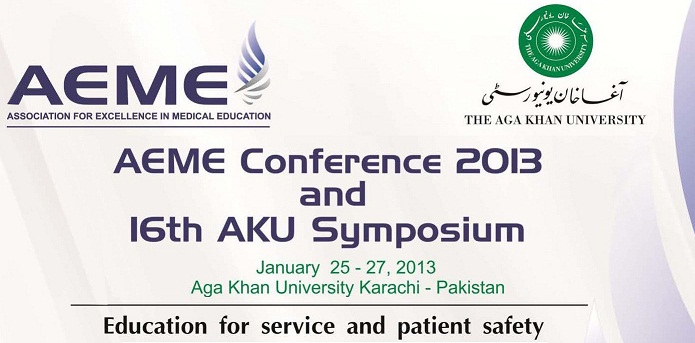Day 2 : Plenary III (Theme: Licensure & Re-certification)
Medical education and patient safety – the new challenge?
Location
AKU Auditorium
Start Date
27-1-2013 11:00 AM
Abstract
"Health care used to be simple, safe and ineffective; today, it is complex, effective and potentially dangerous. We have to change the way we teach the next generation of providers. Other high-reliability organizations start from day one with safety training. We need to do that." said Dr. Mayer. Optimal health care revolves around how to deliver the right care to the right patient at the right time, and how to prevent a patient from being harmed. Medical errors have high human and financial costs - in the US alone up to 98, 000 deaths a year could be attributed to medical error, costing between $17bn and $29bn. Despite this 45% of medical students considered their training on quality assurance “insufficient.” Medical errors are of two types: active errors produced by human hands and are possibly addressable through appropriate education and practice. Latent errors result from poorly designed or implemented systems or procedures and are likely addressable through the education of system developers and management. Physician trainees use the mechanisms of denial, discounting, and distancing to define and defend medical error. Recurrent themes in errors, such as uncertainty, fallibility, and exclusivity of judgment are probably rooted in medical education. To this end, four such domains are recognized: clinical systems, human factors and communication, knowledge representation, and protection of confidentiality. The education of clinicians to the importance of avoiding medical errors and mitigating risks to patients should be paramount in any medical school curriculum. Yet very few training programs identify formal education in medical errors or patient safety. Even in developed countries with advanced health and education systems the integration of patient safety education into the existing curriculum in medical schools provides significant challenges. To help medical schools introduce and promote patient safety education, the World Health Organization (WHO) published the "WHO Patient Safety Curriculum Guide for Medical Schools" in 2009. It focuses on eleven topics, derived from the evidence based, Australian Patient Safety Education Framework" and underwent formal evaluation. In our training besides the traditional ones, the non-technical and professional competencies such as situational awareness, teamwork and leadership, communication and collaboration, risk management and human factors need to be explicitly taught and assessed. It has to be recognised that the key to patient safety education lies in prevention, not remedy, so the ideal educational strategy with regard to patient safety is that it should be taught throughout the entire curriculum with all opportunities taken to teach students to prevent mistakes in clinical practice and improve safety and quality of care.
Medical education and patient safety – the new challenge?
AKU Auditorium
"Health care used to be simple, safe and ineffective; today, it is complex, effective and potentially dangerous. We have to change the way we teach the next generation of providers. Other high-reliability organizations start from day one with safety training. We need to do that." said Dr. Mayer. Optimal health care revolves around how to deliver the right care to the right patient at the right time, and how to prevent a patient from being harmed. Medical errors have high human and financial costs - in the US alone up to 98, 000 deaths a year could be attributed to medical error, costing between $17bn and $29bn. Despite this 45% of medical students considered their training on quality assurance “insufficient.” Medical errors are of two types: active errors produced by human hands and are possibly addressable through appropriate education and practice. Latent errors result from poorly designed or implemented systems or procedures and are likely addressable through the education of system developers and management. Physician trainees use the mechanisms of denial, discounting, and distancing to define and defend medical error. Recurrent themes in errors, such as uncertainty, fallibility, and exclusivity of judgment are probably rooted in medical education. To this end, four such domains are recognized: clinical systems, human factors and communication, knowledge representation, and protection of confidentiality. The education of clinicians to the importance of avoiding medical errors and mitigating risks to patients should be paramount in any medical school curriculum. Yet very few training programs identify formal education in medical errors or patient safety. Even in developed countries with advanced health and education systems the integration of patient safety education into the existing curriculum in medical schools provides significant challenges. To help medical schools introduce and promote patient safety education, the World Health Organization (WHO) published the "WHO Patient Safety Curriculum Guide for Medical Schools" in 2009. It focuses on eleven topics, derived from the evidence based, Australian Patient Safety Education Framework" and underwent formal evaluation. In our training besides the traditional ones, the non-technical and professional competencies such as situational awareness, teamwork and leadership, communication and collaboration, risk management and human factors need to be explicitly taught and assessed. It has to be recognised that the key to patient safety education lies in prevention, not remedy, so the ideal educational strategy with regard to patient safety is that it should be taught throughout the entire curriculum with all opportunities taken to teach students to prevent mistakes in clinical practice and improve safety and quality of care.

